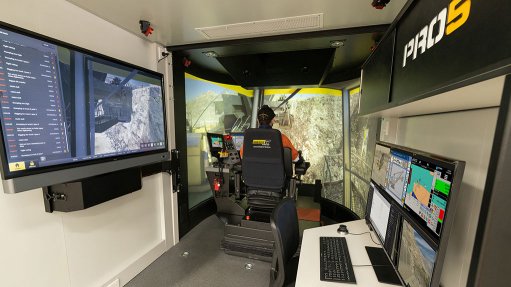Loadshedding resulted in 25% y/y employment drop in metals, engineering sector
A recent study carried out by the Steel and Engineering Industries Federation of Southern Africa (Seifsa) to assess the impact of loadshedding on the metals and engineering sector reveals a weighted average employment reduction across the industry of -25.32% from February 2022 to February this year.
“The employment losses, mostly attributable to companies responding to the energy crisis over the period, indicate some very concerning trends. A quarter of companies indicated that they have had to reduce headcount in response to the electricity crisis by as much as a quarter of their employment,” Seifsa COO Tafadzwa Chibanguza revealed on the first day of a Seifsa-hosted Metal Industries Collective Bargaining Summit, in Johannesburg, on May 24.
He noted that the year-on-year losses in employment across the sector amounted to about 9 432 people.
Moreover, nearly half of companies in the metals and engineering sector (42.6%) indicate that they had cancelled investment or expansion plans owing to the uncertainty caused by the electricity crisis.
The value of these lost investments amounted to R2.64-billion, which would have had the potential of creating at least 1 620 jobs. Of this, 3% was planned greenfield investment, 41% brownfield and 56% sustaining investment.
About 37% of the value of these cancelled investments was redirected towards alternative energy investments instead.
“The amount invested into alternative energy sources of R985-million is considerable when put into perspective that it accounts for so much of the value of investments cancelled. This highlights the point that companies are sacrificing scarce long-term capital to fulfil immediate survival, presenting long-term adverse implications regarding the sustainability of the sector,” Chibanguza bemoaned.
Moreover, increases in production could no longer be translated to proportionate increases in employment within the metals and engineering sector, Chibanguza said.
“There is a deterioration of that relationship. We need as much as a 5% increase in production for a 1% increase in employment.
"However, the metals and engineering sector has been contracting at -1.3% on a compound yearly basis since 2008 and employment has followed that downward trend,” he said, noting that the labour costs make up 18% of total input cost but 79% of metals and engineering sector GDP.
In 2022, the metals and engineering sector employed 374 496 employees, of which 217 618 were factory workers. This represented a 0.8% increase of 1 064 employees over 2021, amounting to a total compensation of R107.7-billion.
Speaking at the summit, which was hosted by Seifsa, Chibanguza said the metals and engineering sector currently constituted 26.15% of the manufacturing sector based on output, representing the metal production, fabrication, the heavy engineering value chain and the plastic product subsector.
He noted that, while the bounce back from the Covid-19 pandemic was sharp, production remained 1.6% below pre-Covid-19 levels and 5.2% below the adaptive moving average. Meanwhile, output-adjusted capacity use has been recorded at 76.2%, notably below the 85% optimal capacity level.
The sector’s real gross domestic fixed investment declined by 9.2% in 2022, while fixed capital stock has also continued to deteriorate because net investment has not been sufficient, presenting a long-term risk to the competitiveness of the sector.
Meanwhile, the structure of the export to domestic sales split has shifted considerably over the past 20 years in favour of exports, owing to increased levels of globalisation.
Overall, however, the global economic environment remains constrained and less supportive for demand in the medium term, Chibanguza explained, putting added strain on the sector.
“Stubbornly high inflation and higher interest rates for longer are a constraint to economic activity and investment,” he said, noting how other global factors such as geo-political tensions in the European Union and sluggish US economic growth had also served to constrain economic growth and perpetuate high inflation rates.
Locally, loadshedding was perceived as one of the biggest problems affecting employment in the metals and engineering sector.
“On a weighted average basis, companies have indicated increases to monthly operating costs to the extent of 24.9% from the extensive use of generators. This does not bode well for a sector whose input costs are running at 11%,” Chibanguza noted.
He said the less supportive demand environment meant that companies in the local metals and engineering sector could not easily pass on the increased costs, resulting in a considerable margin squeeze and a threat to the long-term sustainability of the sector.
Article Enquiry
Email Article
Save Article
Feedback
To advertise email advertising@creamermedia.co.za or click here
Comments
Research Reports
Projects
Latest Multimedia
Latest News
Showroom
Immersive Technologies is the world's largest, proven and tested supplier of simulator training solutions to the global resources industry.
VISIT SHOWROOMPress Office
Announcements
What's On
Subscribe to improve your user experience...
Option 1 (equivalent of R125 a month):
Receive a weekly copy of Creamer Media's Engineering News & Mining Weekly magazine
(print copy for those in South Africa and e-magazine for those outside of South Africa)
Receive daily email newsletters
Access to full search results
Access archive of magazine back copies
Access to Projects in Progress
Access to ONE Research Report of your choice in PDF format
Option 2 (equivalent of R375 a month):
All benefits from Option 1
PLUS
Access to Creamer Media's Research Channel Africa for ALL Research Reports, in PDF format, on various industrial and mining sectors
including Electricity; Water; Energy Transition; Hydrogen; Roads, Rail and Ports; Coal; Gold; Platinum; Battery Metals; etc.
Already a subscriber?
Forgotten your password?
Receive weekly copy of Creamer Media's Engineering News & Mining Weekly magazine (print copy for those in South Africa and e-magazine for those outside of South Africa)
➕
Recieve daily email newsletters
➕
Access to full search results
➕
Access archive of magazine back copies
➕
Access to Projects in Progress
➕
Access to ONE Research Report of your choice in PDF format
RESEARCH CHANNEL AFRICA
R4500 (equivalent of R375 a month)
SUBSCRIBEAll benefits from Option 1
➕
Access to Creamer Media's Research Channel Africa for ALL Research Reports on various industrial and mining sectors, in PDF format, including on:
Electricity
➕
Water
➕
Energy Transition
➕
Hydrogen
➕
Roads, Rail and Ports
➕
Coal
➕
Gold
➕
Platinum
➕
Battery Metals
➕
etc.
Receive all benefits from Option 1 or Option 2 delivered to numerous people at your company
➕
Multiple User names and Passwords for simultaneous log-ins
➕
Intranet integration access to all in your organisation





















